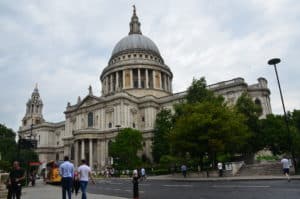Last updated on .
St. Paul’s Cathedral is one of the most iconic buildings in London, England. It’s located in the City of London and is the seat of the Bishop of London. This entry explores the history of the building as well as its exterior features.

History
This Anglican cathedral dates back to 604, when King Sæberht of Essex converted to Christianity. His uncle, King Æthelberht of Kent, built a cathedral in London dedicated to St. Paul the Apostle as the seat of the first Bishop of London, Mellitus. The first cathedral was either destroyed and rebuilt, or restored in the late 7th century and destroyed by fire in 962. Another cathedral was built in 962 and destroyed by fire in 1087.
The latest fire made way for what’s now known as Old St. Paul’s Cathedral, which was constructed between 1087 and 1314. When it was complete, it was one of the longest churches in the world and had one of the tallest spires in the world. The spire caught fire on June 4, 1561, and collapsed. Just like the earlier cathedrals, Old St. Paul’s was destroyed by fire during the Great Fire of London from September 2-6, 1666.
The current cathedral was build by architect Sir Christopher Wren. Construction started in 1675 and the cost was covered by a special tax on coal. It was consecrated for use on December 2, 1697, but construction continued on for several years. It was declared officially complete by Parliament on December 25, 1711. Wren is buried in the crypt underneath the building considered his masterpiece.
In recent years, St. Paul’s Cathedral was struck by bombs during the Blitz from October 10, 1940, and April 17, 1941. The cathedral witnessed three important state funerals: Admiral Horatio Nelson (1805), Duke of Wellington (1852), and Winston Churchill (1965). The wedding of Prince Charles and Lady Diana Spencer took place there on July 29, 1981. Between 1996 and 2011, the building and dome underwent a 15 year restoration process.
Dome
The most prominent feature of St. Paul’s Cathedral is the dome. It rises 365 feet above ground level and was the tallest building in London from 1711 to 1967. It was inspired by the dome of St. Peter’s Basilica in Rome and the Church of the Val-de-Grâce in Paris.
West Front
The west front of the cathedral is the main entrance and most ornate part of the exterior. It contains a portico supported on two tiers of paired columns, flanked by two towers. Each tower is crowned by a gilded copper pineapple. The towers stand outside the width of the aisles inside the cathedral.
Between the towers is a pediment topped by a statue of St. Paul carved by Francis Bird between 1718 and 1721. The relief in the center of the pediment depicts St. Paul’s conversion to Christianity.
If you look carefully, you’ll notice only one of the two towers contains a clock. The clock in the southwest tower is called “Big Tom” and is 16 feet in diameter. The first clock was installed in 1709 by Langley Bradley but was worn out by the late 1800s. Big Tom was built in 1893 by Smith of Derby.
The southwest tower also contains four bells, the largest being Great Paul. It was cast in 1881 by Taylor’s Bell Foundry and weighs 16 ½ long tons. Great Paul was the largest bell in the British Isles until the casting of the Olympic Bell for the 2012 London Olympics. It traditionally sounds at 1pm each day. Another bell, Great Tom, chimes on the hour and is tolled to announce a death in the royal family.
Statue of Queen Anne
In front of St. Paul’s Cathedral is a statue of Queen Anne, who was the ruling British monarch when the cathedral was officially completed. The statue is a copy of an original 1712 sculpture by Francis Bird.
The current statue was sculpted by Richard Claude Belt and unveiled on December 15, 1886. It was commissioned to replace the older statue, which was badly weathered and damaged over the years.
St. Paul’s Cross
On the northeast side of the cathedral in St. Paul’s Churchyard once stood St. Paul’s Cross, which was the most important public pulpit in England. The pulpit stood from 1449 to 1635. During the Reformation, William Tyndale’s New Testament was burned there because it was translated into English.
A column topped by a gilded statue of St. Paul stands near the original site of the pulpit. The statue was made by Australian sculptor Bertram Mackennal between 1908 and 1910.